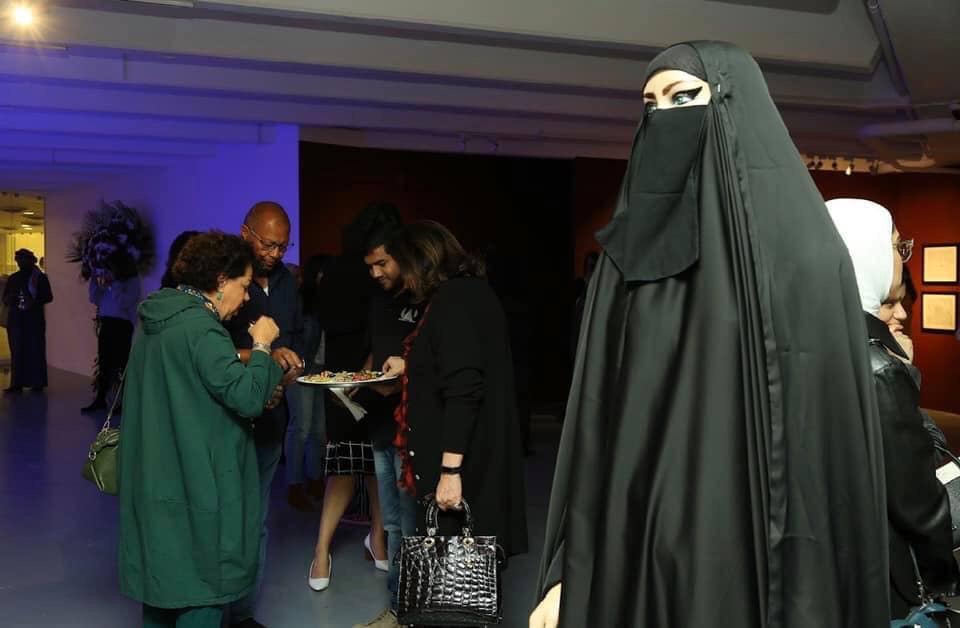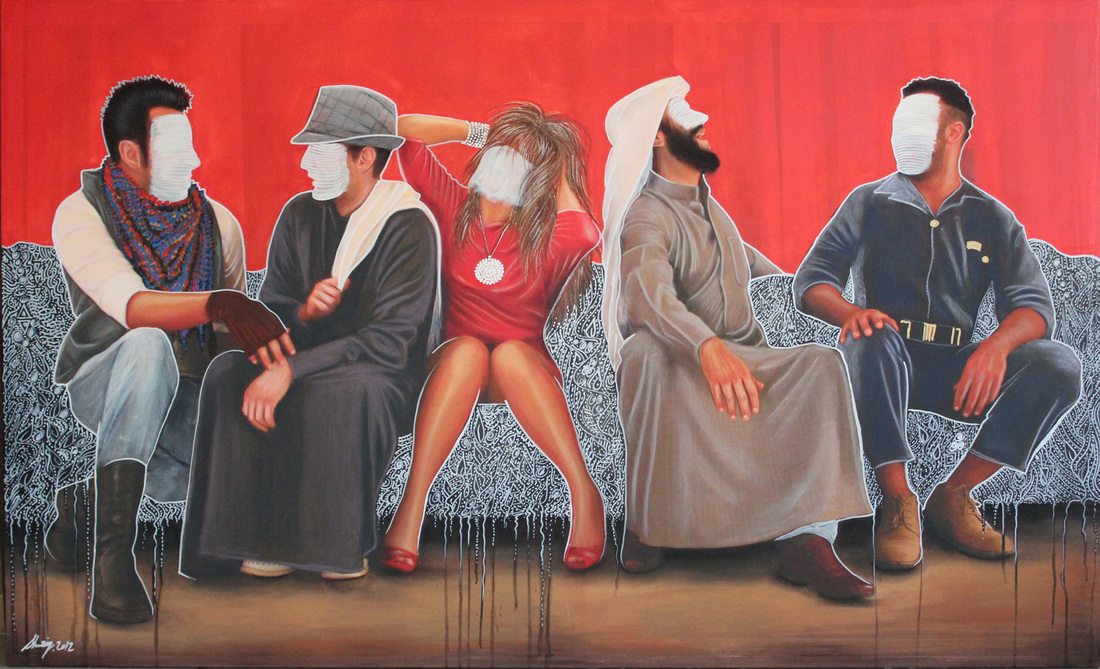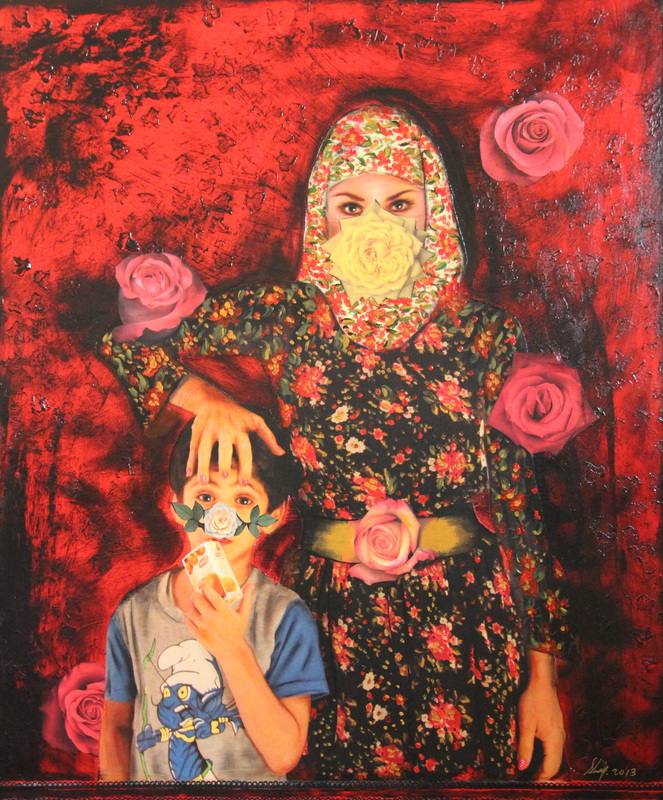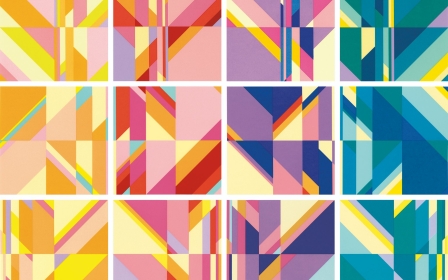'Forbidden fruit': Kuwait's taboo-breaking artist on sex, sin and censorship

It came as little surprise to Kuwaiti artist Shurooq Amin that her latest exhibition was shut down by the authorities just a week after it opened. Her work has always sparked controversy; her 2012 show, It's A Man's World, was closed down just three hours after its launch.
Amin's most recent defiant display, Like Russian Dolls We Nest in Previous Selves, was inaugurated on 8 January. It was planned to run for a month at the Contemporary Art Platform (CAP), one of the most progressive art centres in Kuwait. But a week after opening, the exhibition was dramatically shut down and her work ordered to be removed.
Though authorities released no official statement, CAP said they were told they hadn't obtained "a prior licence from the concerned authorities" and that there were "claims that the exhibition contained elements in violation of the publishing law of the Ministry of Information".
Amin, however, believes it was because of "the portrayal of women" and "sexy scenes".
New MEE newsletter: Jerusalem Dispatch
Sign up to get the latest insights and analysis on Israel-Palestine, alongside Turkey Unpacked and other MEE newsletters
In Like Russian Dolls We Nest in Previous Selves , a set of portraits show women sitting on thrones, some in revealing clothing and languid poses with bottles of what appears to be alcohol.
In the main gallery space, mannequins were positioned to look like visitors viewing the artwork. A few empty bottles - again symbolising alcohol - lay scattered at the feet of some of the mannequins. Another was seated on a bench, holding a black handbag with the word "sinner’" printed on it.
In a country where alcohol is illegal, the bottles might be controversial enough. But the traditionally dressed mannequins looking at the portraits of the scantily clad women may also have provoked debate.
In a statement published on her website, Amin explained that the installation was aimed at representing a symbolic dialogue with a conservative woman who normally would never be part of her audience. It was the artist’s way of “speaking to that woman, to communicate different ideas, to instil in her a sense of empowerment”.
And while the show was still on, visitors shared their experience of it on social media, calling it "daring", "powerful" and "blunt".
On instagram, Amin posted that although some people were "creeped out", "others were left feeling confused but delighted".
‘Art chose me’
Shurooq Amin was the first female Kuwaiti artist to exhibit at the Venice Biennale in 2015, and to have her works auctioned at Christie’s - twice.
Not only a visual artist, Amin is also a writer with three poetry collections and over 50 stories, poems and articles published in literary journals all over the world.
She holds a PhD in Ekphrasis (the relationship between art and poetry) and worked as an English professor at Kuwait University before retiring two years ago.
Born in 1967 to a Kuwaiti father and Syrian mother, she says art has been her passion since she was a young girl. “I've been painting since I was a child, since I could hold a pencil,” Amin says.
“I had my first group art exhibition at the age of nine. I was the youngest artist in Kuwait exhibiting with a bunch of adults. I just continued along that path: I did not choose to become an artist, art chose me.”
Already as a teenager she started to use art as a means of contestation, rebelling against restrictions, unable to express herself, always told what to do or what to wear.
“It was tough growing up as a rebellious girl in Kuwait in the 70s and 80s,” Amin says. “At that time girls were supposed to be quiet and polite. But I was different, I used to wear jeans, I would talk to boys, I didn't fit into labels and boxes, nor could I conform.
"Because of this I was considered an outcast. This has still not changed,” she says.
Amin’s talent was publicly recognised in her early 20s. It was a time in her life when she was voraciously producing new work. She was a newly wed and used her kitchen as a studio where she stored hundreds of her own pieces.
In 1993, Thuraya al-Baqsami, pioneer Kuwaiti artist and novelist, decided to visit Amin after hearing about her. After seeing Amin's work, she helped organise her first solo show at Al Ghadir Gallery.
‘It’s a Man’s World’
The exhibition was a success and nearly all the artwork sold out. Amin was beginning to learn what it felt to have people interact with her art. Her work was not yet provocative, she says, but "tame" and "experimental".
It was only when her marriage started to fall apart, four children later and in her early 40s, that Amin began using art as a message. She says she realised, while getting divorced, that society was against her. “The stigma attached to being a single mother and a divorced woman in Kuwait is very strong,” she says.
“No one would rent out to me as a divorced woman. I don't know what they thought I would be doing with four kids. Did they think I was going to bring men to the flat? It's humiliating. No one would give me a loan, it was financially very challenging... So I started expressing all of that in my work.”
Her personal life began to inspire her art. Her 2010 series Society Girls consisted of a number of provocative works focusing on the lives of women behind Kuwait’s closed doors. The series explored modern Gulf society with images mixing the traditional with contemporary.
Some of the women in the paintings are sitting, hugging or chatting, on sofas decorated with poetry in Arabic calligraphy. Most of them wear abayas and niqabs with stilettos or sandal heels, while exposing parts of their body in revealing poses.
Her next series, in 2012, It’s a Man's World explored the other half of the same society: men. Amin says that she created the series to address the "secret lives" of some "Khaliji [Gulf] men".
'The way it happened was extremely aggressive... [they] literally threw people out and sealed the premises'
- Shurooq Amin
As in Society Girls, in most of the paintings the male figures are faceless, mostly dressed in white, black, brown and grey dishdashas [floor length gowns] and sitting playing cards, smoking shisha, drinking whisky or even holding hands.
Three hours after opening her exhibition, on 5 March 2012 at the Al M. Gallery in Kuwait City, the show was shut down by the Kuwaiti authorities.
“It was very drastic and the way it happened was extremely aggressive," Amin says. "Five men from the Secret Service, the Ministries of Interior, Information and Commerce stormed into the gallery that night, literally threw people out and sealed the premises.”
This is when Amin began to feel ostracised and her work was banned in Kuwait and Saudi Arabia. But the censorship backfired as the artist instead gained international notoriety and many galleries abroad started to court her.
She chose to be represented by Ayyam Gallery in Dubai because she felt it was the only gallery that really understood her work.
Khaled Samawi, owner of the Emirati gallery, told MEE that Ayyam was excited to represent Shurooq because “she is a thinker and wants her viewers to have an open minded discussion about taboos or subjects considered uncomfortable by Islamic societies. We believe that art, besides being beautiful, should be poignant and stimulate both the mind and the soul.”
'It's a Mad World'
Four years after the shutting down of her 2012 show, Amin was invited back to exhibit in Kuwait by the owner of CAP who realised the enormous potential of the artist and her works.
Amin agreed, on one condition – no censorship.
Amin's 2016’s exhibit at CAP, It's a Mad World, included a large installation about alcoholism made with 500 empty bottles of liquor that the artist had gathered from Kuwaiti families over a year. In a dark room, lit only by spotlights, the bottles were placed on a table and hung from the ceiling.
'[It was] the most powerful installation I ever did. People were leaving the room crying'
- Shurooq Amin
The exhibit also included a painting inspired by The Last Supper by Leonardo da Vinci. Titled The Last Sip, it portrayed the same woman in 13 different poses, sitting at a table full of whisky and vodka bottles, crying or desperate for help.
It was in fact a self-portrait of the artist, with each character displaying an emotion suffered by those who are in a relationship with an alcoholic.
The work denounced the fact that people who suffer from alcoholism cannot find support in Kuwait because alcohol is illegal – even though it can be bought at exorbitant prices on the black market. As a consequence the problem cannot be solved or even acknowledged.
This time, the exhibition was allowed to run its full course. “[It] was not shut down which is surprising as I consider it the most powerful installation I ever did. People were leaving the room crying,” Amin says.
Forbidden fruit
But her work has drawn criticism from those who view it as the antithesis of Kuwaiti values and culture. "Art doesn't mean indecency. Art doesn't mean nudity. Art doesn't mean the destruction of values," wrote journalist, blogger and political activist Dahem al-Qahtani on Twitter, in support of the closure of Amin's recent exhibition.
The Ministry's decision, he added, "was not a war against creativity" rather a "duty...to protect society from violating public order and insulting public morals".
"I will paint whatever I feel needs to be said," Amin says. "Even if that's about child marriages, corruption, adultery, homosexuality, alcoholism... and religious and sexual hypocrisy.
"I am in the wrong place at the wrong time. However, if there's anything we learn from history, it's that creative people who were lynched or silenced during their time, are the ones that have moved our culture forward.”
Another one of her more powerful works, is This Way Up - Painting the Roses Red (2014) which portrays a veiled woman lifting the eyelids of her son. She says it represents a metaphor for raising a boy who will grow up to be an open-minded man.
“I would like to pass the message on that people can still hold on to the past, respect traditions and raise loving children who grow up to be tolerant and accepting of diversity,” she explains.
But it is the series which was censored in 2012 that she feels was pivotal to her career, because it brought her to the international arena.
The latest censorship episode has now brought her more fame and followers on social media, to the extent that Amin is struggling to keep up with her growing number of supporters in a community created through her work.
Ironic really for the artist who still feels misunderstood by her own country.
“Censorship made things turn around for me. It just proved that it is ridiculous, as forbidden fruit is the sweetest. When you censor something, people are going to be more interested.”
This article is available in French on Middle East Eye French edition.
Middle East Eye delivers independent and unrivalled coverage and analysis of the Middle East, North Africa and beyond. To learn more about republishing this content and the associated fees, please fill out this form. More about MEE can be found here.









